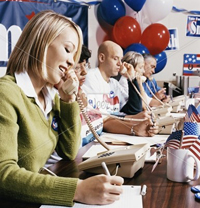 GOTV mobilization is a challenge for any campaign. How a campaign allocates its resources in this late, crucial stage of the campaign can make the difference between winning and losing. There are so many questions to address. Should we hit the field with another mail piece or do we another ad buy? What will the call universe look like? What about doing a paid canvass? There are so many considerations that it can be a challenge to get the correct mix of ingredients.
GOTV mobilization is a challenge for any campaign. How a campaign allocates its resources in this late, crucial stage of the campaign can make the difference between winning and losing. There are so many questions to address. Should we hit the field with another mail piece or do we another ad buy? What will the call universe look like? What about doing a paid canvass? There are so many considerations that it can be a challenge to get the correct mix of ingredients.
While it might be tempting to wait until the last two weeks of a campaign cycle to do your big push, it’s unlikely that such last minute messaging efforts will able to penetrate through the clutter of GOTV messages that are competing for a voter’s attention. Campaigns need to be more strategic about how they target voters and the timeframe they deliver these messages.
Campaigns are becoming more strategic in the targeting of their message through cookie-based online digital advertising. Online political ad networks are by no means a new concept, but the use of data aggregation from user web browsing tracking that is matched with voter file data, allows advertisers to deliver highly targeted political messages.
These ads rely on tracking a users browsing history. The sites that a user visits are tracked with web based cookies. A cookie is a snippet of code that follows the sites that the user visits online. Sites use these cookies to identify what types of ads you would like to see. If you’ve ever visited a pet related site, you might later on encounter a “Pet Lovers for Obama” banner ad. In this case, the Obama campaign's ad network is reading your cookies to be able to deliver ads that are inline with your interests.
Once this browser data is matched with the data from the voterfile advertisers can begin targeting their ads with the same precision of a direct mail piece and deliver the rich media of a television ad. If the campaign wants to target their "Pet lovers for Obama" ad specifically to politically moderate women who have voted in at least two of the last three elections, they can match their voter file records against their browsing data. To make their ad more engaging campaigns can deliver streaming video and rich media.
To optimize the digital media strategy the campaign should reinforce the political ad messages through field persuasion efforts. As soon as the voter views the digital ad, the voter should be contacted by a campaign canvasser or phone banker using an autodialer solution, or candidate voice broadcast introduction to reinforce the ad message. Campaigns can use the browsing data to discern the voter interests and connect voters with a volunteer of similar interests. These sequential voter contacts will go far in reinforcing a campaigns targeted message.
The timeframe for these efforts should be well in advance of Election Day. In the last three weeks of an election voters are inundated with campaign advertisements. The clutter of advertising makes it difficult to for the voter to internalize any particular message. Delivering ads months in advance of the campaign push make them less likely to be ignored.
Like digital advertising, a campaigns telecom strategy should be devised well in advance of Election Day. SMS text messaging has proven to be a highly effective medium to mobilize supporters. The Scott Brown for Senate campaign, for example, was able to use SMS text messages to quickly mobilize supporters around a call to action. In one case, the campaign had sent text messages to its supporters to call a local radio station where their opponent, Martha Coakley, was doing an interview. The supporters were able to inundate the station with hard pressing questions.
The Scott Brown text message strategy shows how effective SMS text messaging can be in mobilizing supporters to take action quickly. Such a strategy requires extensive planning. Political text messaging requires opt-in consent from the supporter. Generating an opt-in list takes months of planning and organizing.
The 2008 Obama campaign provides an example of how to effectively create an opt-in database. Even before Senator Obama announced his candidacy for the presidency, Obama was building his database by requiring supporters who attended fundraising and supporter events to provide their cell phone numbers and opt-in to receive campaign texts. Supporter emails included opt-in buttons to receive campaign SMS blasts. By the time he announced his candidacy, Obama had already amassed a significant list of opt-in cell phone numbers and he was able to mobilize and inform supporters quickly when he needed them.
These examples illustrate the work involved with making a comprehensive political telecom strategy. Creating SMS opt-in lists and targeting your message will insure that you can persuade and mobilize voters more effectively in November.
